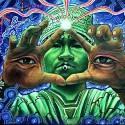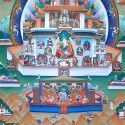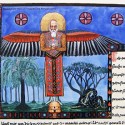
There are a number of human experiences that are characterized by presentness, detail, externality, and three-dimensional explorable spacefulness: we can call these visionary experiences. These can be characterized along two dimensions — according to the degree to which the experience is entered into intentionally, and by the amount of control the experiencer exercises over its content. Such visionary experiences appear to be quite widespread across cultures, and raise significant psychological and ontological questions.

Chinese philosophy — perhaps because of its origins in practical political thought — has been dominated by questions of change: why is there change rather than stability? what is the relationship between change and human action? are there patterns of change that we can detect and use to our advantage? The concept of the wŭxíng 五行 was proposed by the philosopher Zou Yan 鄒衍 (fl. c. 350-270 BCE) as one answer to that last question. The idea has become central to Chinese culture.

Of all the claims for the power of ayahuasca to heal sicknesses of various kinds, from cancer to asthma, the most popular current claim is that ayahuasca can — in some sense — cure addiction. There are certainly anecdotes, claims, and uncontrolled self-report studies that can at best be called preliminary. But I have seen no substantial scientific evidence that ayahuasca can successfully treat addictions. Here is why I am cautious about such claims.

The meridians — also called channels, pathways, and other names — are a central concept of Chinese medicine.They are the way that the zàngfǔ or organs extend their regulative processes throughout the body. But the meridians — like the zàngfǔ — are not themselves anatomical objects. Rather, they are streams of qì as experienced from within the lived body.

Some time ago, on a discussion group, a woman posted that she had been sexually assaulted by a shaman at an ayahuasca retreat center in the Upper Amazon. During the course of the occasionally heated discussion that followed, I took the position — which I still maintain — that it is unethical for a shaman to have sex with a patient under any circumstances, even when the sex is apparently consensual. I reproduce the relevant portions of my posts here.

Eidetic visualization — the creation of a minutely detailed mental image of the deity being contemplated, along with the deity’s palace, retinue, appurtenances, and the subtle deities distributed on the divine body — lies at the heart of Tibetan tantric meditation. The practice is ultimately linked to a wave of visionary devotionalism that began in India in the early centuries CE, affecting both Buddhism and the Hindu Vaiṣṇava tradition. The Buddhists, with long practice in eidetic visualization, have important things to say about visionary ontology.

Carl Jung believed that active imagination is a channel for messages from the unconscious. Most important, the dialogue with the contents of the unconscious is with persons — “exactly as if,” says Jung, “a dialogue were taking place between two human beings with equal rights.” Active imagination enters its own visionary landscape, often called the imaginal world. Immediately we face the question of the nature and ontological status of the persons we encounter there.

On November 16, 2009, after a brief illness, famed visionary artist Pablo César Amaringo died at his home, surrounded by friends and family, and leaving behind a mass of uncatalogued paintings and hastily jotted notes. We are more than fortunate that Howard Charing and Peter Cloudsley had already been working with Amaringo for months to get his collection in order, annotate his more recent work, create a digital archive of his art, and protect his paintings from deterioration in their humid tropical environment.
Browse the Full Collection of Articles
- Visionary Experiences
Mar, 2014 - On Chinese Medicine: The Five Xíng
Mar, 2014 - Ayahuasca and Addiction
Mar, 2014 - On Chinese Medicine: The Meridians
Mar, 2014 - Sex with the Shaman
Jan, 2014 - Visualization Before Tantra
Jan, 2014 - Dreaming with Open Eyes
Jan, 2014 - The Shamanic Art of Pablo Amaringo
Jan, 2014 - The Anthropology of Consciousness
Jan, 2014 - Body Practice
Dec, 2013 - The Hunger Artist
Dec, 2013 - Sometimes It Rains
May, 2013 - You Can’t Call 911 in the Jungle
Oct, 2012 - Ayahuasqueros
Aug, 2012 - A Peyote Joke
Aug, 2012 - A New Ayahuasca Study
Aug, 2012 - Vodka, Ayahuasca, Found Footage
Aug, 2012 - Is Ayahuasca Neurotoxic?
Jul, 2012 - Fourteen Dead Shamans
Jul, 2012 - Thinking About Death III: Stories
Jun, 2012 - Thinking About Death II: Levinas
Jun, 2012 - Thinking About Death I: Heidegger
Jun, 2012 - Ayahuasca and the Grotesque Body
May, 2012 - What Do the Spirits Want from Us?
May, 2012 - Traveling Safely to Drink Ayahuasca
May, 2012 - On the Origins of Ayahuasca
Apr, 2012 - The Collective Unconscious
Sep, 2009 - Amazonian Gastronomy
Sep, 2009 - Metamorphosis
Sep, 2009 - Sacred Mushrooms of Mexico
Aug, 2009 - A Love Story
Aug, 2009 - Sex and Violence in Amazonia
Aug, 2009 - The Gift of Diabetes
Aug, 2009 - Susun Weed, Herbalist
Aug, 2009 - Amazonia Barbie
Aug, 2009 - Heidegger the Shaman
Aug, 2009 - Salvia on Schedule
Aug, 2009 - Plants of the Ancient Maya
Aug, 2009 - The Shulgin Documentary
Aug, 2009 - The Mystery of Ulluchu
Aug, 2009 - Painting the Plants with Light
Aug, 2009 - Krippner on Ayahuasca
Aug, 2009 - Nip/Tuck
Aug, 2009 - Spirit Stuff
Aug, 2009 - Sacred Justice, Part 1
May, 2009 - Wounds in the Jungle
Mar, 2009 - Bioneers
Mar, 2009 - Eagle Feathers
Mar, 2009 - The Last Man
Mar, 2009 - Handling Infections
Mar, 2009 - Green Power
Mar, 2009 - A Victory for Santo Daime
Mar, 2009 - The War on Coca Leaves Redux
Mar, 2009 - Hyperthermia
Mar, 2009 - Peyote Songs
Mar, 2009 - Dealing with Snakebite II
Mar, 2009 - Dealing with Snakebite I
Mar, 2009 - The Psychedelic Review
Mar, 2009 - A New Ayahuasca Book
Mar, 2009 - Listening to the Dreamer
Mar, 2009 - Clean Water
Mar, 2009 - Jungle Madness
Mar, 2009 - The Magic Mosquito Net
Mar, 2009 - Native American Film Festival
Mar, 2009 - Ayahuasca and Mental Health Among the Shuar
Mar, 2009 - Mark Your Calendar
Mar, 2009 - Primer Festival de la Selva Peruana
Mar, 2009 - El Dorado
Feb, 2009 - Yuwipi Man
Feb, 2009 - Animated Ayahuasca
Feb, 2009 - Telling Dreams
Feb, 2009 - Literary Shamanism
Feb, 2009 - The Natufian Shaman
Feb, 2009 - How to Build a House
Feb, 2009 - Soul Ayahuasca
Feb, 2009 - Good Blog: Legitimos Guerreritos
Feb, 2009 - A Golden Guide to Hallucinogenic Plants
Feb, 2009 - Jaguar on Ayahuasca
Feb, 2009 - The Dimethyltryptamine Receptor
Feb, 2009 - Indigenous Top-Level Domains
Feb, 2009 - Psychoactive Plants Online
Feb, 2009 - Psychointegration
Feb, 2009 - Philip Glass on the Amazon
Feb, 2009 - Curing
Feb, 2009 - The Great Amazon Raft Race
Feb, 2009 - Two Songs of My Teacher
Feb, 2009 - The Telepathy Meme Again
Feb, 2009 - Hallucinogens and Pornography
Feb, 2009 - Soccer
Feb, 2009 - The Survival of Plant Knowledge
Feb, 2009 - Conference Notes
Feb, 2009
- Weeds
Feb, 2009 - The Importance of Plant Knowledge
Jan, 2009 - Jungle Music
Jan, 2009 - Best New Product of 2009
Jan, 2009 - Pierre Clastres
Jan, 2009 - Entheogen: The Movie
Jan, 2009 - Magic Stones
Jan, 2009 - Fire on the Mountain
Jan, 2009 - Long-Term Peyote Use
Jan, 2009 - Ayahuasca and Cancer
Jan, 2009 - In Search of the Divine Vegetal
Jan, 2009 - Extreme Celebrity Ayahuasca
Jan, 2009 - Jacques Mabit
Jan, 2009 - Terence McKenna on Hope
Jan, 2009 - Good Blogs: Psychedelic Research
Jan, 2009 - An Experiential Typology of Sacred Plants
Jan, 2009 - Heirloom Snuffing Kits
Jan, 2009 - The Single Active Molecule
Jan, 2009 - Ancient Andean Hallucinogens
Jan, 2009 - The Amazon River
Jan, 2009 - An Ayahuasca Documentary
Jan, 2009 - Uncontacted Tribes Again
Jan, 2009 - Uncontacted Tribes
Jan, 2009 - Moses and Ayahuasca
Jan, 2009 - Xanadu Xero’s Challenge
Jan, 2009 - Ayahuasca and Transient Psychosis
Jan, 2009 - The Tragic Cosmovision
Jan, 2009 - Whole Earth Review
Jan, 2009 - Classifying Plants
Jan, 2009 - Perspectivism
Jan, 2009 - Ayahuasca: National Cultural Heritage
Jul, 2008 - A Parable
Jul, 2008 - Policing Sorcery
Jun, 2008 - Shamanism and Rubber
Jun, 2008 - Vance Gellert
Jun, 2008 - Venefices
Jun, 2008 - Strassman Redux
Jun, 2008 - Endogenous Dimethyltryptamine
Jun, 2008 - Jungle and Rainforest
Jun, 2008 - Hallucinogens in Africa
May, 2008 - More Legal Stuff
May, 2008 - Going Fishing
Apr, 2008 - Animated Shamanism
Apr, 2008 - Shamanism Conference
Apr, 2008 - Learning to Sing
Apr, 2008 - Snakebite
Apr, 2008 - Video Amazonia Indigena
Apr, 2008 - The Tragedy of Don Carlos
Apr, 2008 - How I Became a Sorcerer
Apr, 2008 - Two Articles
Apr, 2008 - Sasha Redux
Apr, 2008 - Beta-Carbolines
Apr, 2008 - The War on Drugs
Apr, 2008 - Self-Control
Mar, 2008 - Why Dogs Do What They Do
Mar, 2008 - Two Coyote Poems
Mar, 2008 - Daniel Mirante
Mar, 2008 - Some Announcements
Mar, 2008 - The War on Coca Leaves
Mar, 2008 - Some Thoughts on DMT Art
Mar, 2008 - The Jungle Cookbook
Mar, 2008 - Terry Riley’s Peyote Ceremony
Mar, 2008 - Virotes
Mar, 2008 - Visionary Information
Mar, 2008 - Shamans and Herbalists
Feb, 2008 - Prestige and Hierarchy
Feb, 2008 - Brujo
Feb, 2008 - Shamanic Specializations
Feb, 2008 - Animist Sculpture
Feb, 2008 - The Tragedy of Maria Sabina
Feb, 2008 - Hallucinogens in North America
Feb, 2008 - Hallucinogens in Siberia
Feb, 2008 - The Hallucinogen Culture Area
Feb, 2008 - What Are Spirits?
Feb, 2008 - Protective Spirits
Feb, 2008 - A Death in the Jungle
Feb, 2008 - Plant Knowledge
Feb, 2008 - The Chacra
Feb, 2008 - Beat Ayahuasca
Feb, 2008 - How Plant Spirits Appear
Feb, 2008 - Women and Ayahuasca
Feb, 2008 - Shrooms
Feb, 2008 - Ayahuasca Mainstreamed
Feb, 2008 - Selling Spirituality
Feb, 2008 - Magic
Feb, 2008 - Canaima
Feb, 2008 - Buryat Shamanism Exhibit
Feb, 2008 - Khadak
Jan, 2008 - The Leaf-Bundle Rattle
Jan, 2008 - Three Ceremonies
Jan, 2008 - Indigenists and Universalists
Jan, 2008
- Phlegm
Jan, 2008 - Mishmash
Jan, 2008 - Joe Rogan on DMT
Jan, 2008 - Animism
Jan, 2008 - The Theft of Voice
Jan, 2008 - How Old is Shamanism?
Jan, 2008 - Amazon Baskets
Jan, 2008 - Metachoric Experiences
Jan, 2008 - Eagle and Condor
Jan, 2008 - Shaman Superheroes
Jan, 2008 - Shaman of Colors
Jan, 2008 - Ayahuasca in the Supreme Court
Jan, 2008 - Shamans’ Organizations
Jan, 2008 - Ayahuasca Admixtures
Jan, 2008 - Mermaids
Jan, 2008 - The Ayahuasca Patent Case
Jan, 2008 - Arrow Poisons
Jan, 2008 - Marshall Arisman, Shaman
Jan, 2008 - Sorcery as Political Resistance
Dec, 2007 - New Studies of Psychedelics
Dec, 2007 - Frightened and Stolen Souls
Dec, 2007 - Byron Metcalf
Dec, 2007 - Listening to Dreams
Dec, 2007 - Beings of the Air
Dec, 2007 - Dye Plants
Dec, 2007 - Dolphins
Dec, 2007 - Peter Gorman on the Plant Spirits
Dec, 2007 - Camalonga
Dec, 2007 - The Telepathy Meme
Dec, 2007 - Chullachaqui
Dec, 2007 - The Water People
Dec, 2007 - The Idea of the Wilderness
Dec, 2007 - The Tigress of the Jungle
Dec, 2007 - Control of the Spirits
Dec, 2007 - Shamanism and Conjuring
Dec, 2007 - Pantheism
Dec, 2007 - DMT: The Movie
Dec, 2007 - Panpsychism
Dec, 2007 - Alien Dreamtime
Dec, 2007 - More on Protecting Peyote
Dec, 2007 - Burundanga
Dec, 2007 - Soundscape
Dec, 2007 - Eliade’s Shamanism
Dec, 2007 - Cleansing the Pope
Dec, 2007 - Remembering the Plants
Dec, 2007 - Another Icaro, Modernized
Dec, 2007 - Who is an Indian?
Dec, 2007 - Strong Sweet Smells
Dec, 2007 - Protecting Peyote
Dec, 2007 - Ethical Wildcrafting
Dec, 2007 - Blueberry
Dec, 2007 - Who is a Shaman?
Dec, 2007 - Plants and Spirits
Dec, 2007 - Steam Baths
Dec, 2007 - Suri
Dec, 2007 - Olivier Messiaen
Dec, 2007 - Pucalupuna
Dec, 2007 - The Journals of Knud Rasmussen
Dec, 2007 - What Can Shamans Heal?
Dec, 2007 - The Smell of the Jungle
Dec, 2007 - Chiricsanango
Dec, 2007 - Male Potency Enhancers
Dec, 2007 - The Cushma
Dec, 2007 - Norval Morrisseau (1931-2007)
Dec, 2007 - Courage and Power
Dec, 2007 - Extraordinary Anthropological Experiences
Dec, 2007 - The Society for the Anthropology of Consciousness
Dec, 2007 - Hallucinogen Studies in Animals
Dec, 2007 - Knowing Where to Suck
Dec, 2007 - DMT Delivery Systems
Dec, 2007 - Ayahuasca and Schizophrenia
Dec, 2007 - The Omnipresence of the Spirits
Dec, 2007 - The Saga of Rick Strassman
Dec, 2007 - Sucking
Dec, 2007 - The Future of Shamanism in the Amazon
Dec, 2007 - Richard Doyle on Ayahuasca
Dec, 2007 - The Shamanic State of Consciousness
Nov, 2007 - The Journal of Shamanic Practice
Nov, 2007 - A New Study of Icaros
Nov, 2007 - The Shamanic Crisis
Nov, 2007 - Shamanism and Belief
Nov, 2007 - Visionary Tobacco
Nov, 2007 - Amazonian Pipes
Nov, 2007 - Sex and the Plant Spirits
Nov, 2007 - Do Shamans Heal?
Nov, 2007 - The Dark Lady
Nov, 2007 - Testing the Spirits
Nov, 2007 - Vomiting
Nov, 2007 - Celebrity Endorsements
Nov, 2007 - Icaros, Modernized
Nov, 2007 - Shamans and Soul
Nov, 2007

Discussing the article:
Hallucinogens in Africa